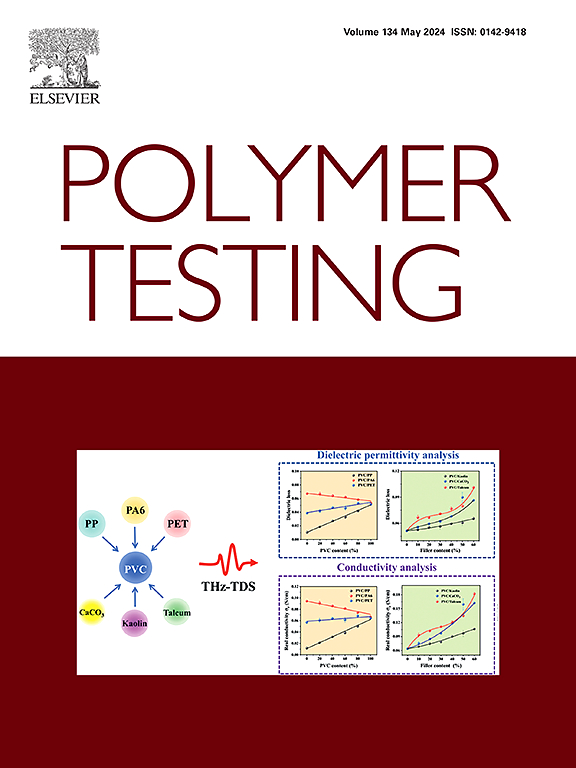利用热解-气相色谱-质谱联用技术实现微塑料的定量分析
IF 5
2区 材料科学
Q1 MATERIALS SCIENCE, CHARACTERIZATION & TESTING
引用次数: 0
摘要
来自日常塑料制品的微塑料污染在全球范围内急剧增加。热解气相色谱-质谱联用技术(Py-GC/MS)已被广泛用于环境样本中微塑料的定性和定量分析。然而,在制定适当的微塑料分析方案时需要考虑几个误区。本研究旨在开发一个内部数据库,其中包含一级(单一)聚合物、二级(两种)聚合物和三级(三种)聚合物混合物。在此背景下,研究了二元和三元聚合物热解过程中可能发生的气相反应。此外,还对不同的稀释剂进行了测试,以准确制备用于定量的校准标准。对于每一种聚合物,都可以确定其特定的峰值,并给出定量分析物的建议。对二元聚合物混合物的分析表明,PET 与 PVC、PVC 与 MDI-PU 和 PE 与 PVC 发生了气相反应。对于这些二元聚合物,可以识别出相应二元聚合物混合物所特有的几种不同的新型热解产物。这些结果证实,在与酯基和醚基聚合物共热解过程中,聚氯乙烯尤其表现出强烈的相互作用。为了准确制备校准标准,测试了不同的稀释剂(二氧化硅、失活二氧化硅、碳酸钙、四氢呋喃和 HFIP)。结果表明,失活二氧化硅只对 PET 的热解有影响。而用二氧化硅稀释则会影响 PA-6/66、PE、PET 和 MDI-PU。总之,我们的研究结果表明,在分析和定量环境样本中的聚合物时,有必要制定国际标准参考材料和标准化分析方案。关键是要使用适合特定聚合物的稀释剂,以排除稀释剂与聚合物之间的潜在相互作用。目前的工作应被视为一个基础,但要充分解决环境样本中聚合物的定量问题,还需要今后的工作。本文章由计算机程序翻译,如有差异,请以英文原文为准。
Towards quantitative microplastic analysis using pyrolysis-gas chromatography coupled with mass spectrometry
Microplastic pollution from everyday plastic items has increased tremendously worldwide. Pyrolysis gas chromatography coupled to mass spectrometry (Py-GC/MS) has been widely investigated for the qualitative and quantitative analysis of microplastics in environmental samples. However, there are several pitfalls to consider when developing an appropriate protocol for their analysis. This study aimed at the development of an in-house database of primary (single) polymers, binary (two) polymers and tertiary (three) polymer mixtures. In this context the potential occurrence of gas phase reactions during pyrolysis of binary and tertiary polymers were investigated. Further, different diluters were tested for the accurate preparation of calibration standards for quantification purposes.
Seven different polymers were included in this study, which were chosen due to their prevalence in daily plastic appliances. For each single polymer specific peaks could be identified and recommendation for quantifier analytes given. The analysis of binary polymer mixtures revealed gas phase reactions for PET with PVC, PVC with MDI-PU and PE with PVC. For these binary polymers, several different novel pyrolysis products, specific for the according binary polymer mixture, could be identified. These results confirmed that especially PVC exhibits strong interactions during co-pyrolysis with ester- and ether-based polymers. Similar results were obtained for tertiary polymers.
For accurate preparation of calibration standards different diluters (silica, deactivated silica, calcium carbonate, THF and HFIP) were tested. It was observed that deactivated silica had only an influence on the pyrolysis of PET. Whereas, dilution with silica affected PA-6/66, PE, PET and MDI-PU. Only PVC was not influenced by dilution with silica.
In conclusion, our results highlight the necessity of an international standard of reference material as well as a standardized analytical protocol for the analysis and quantification of polymers in environmental samples. It is crucial to use diluters suitable for the specific polymer, to exclude potential interactions of diluters with the polymer. The present work has to be seen as a foundation, but future work is needed to adequately address the quantification of polymers in environmental samples.
求助全文
通过发布文献求助,成功后即可免费获取论文全文。
去求助
来源期刊

Polymer Testing
工程技术-材料科学:表征与测试
CiteScore
10.70
自引率
5.90%
发文量
328
审稿时长
44 days
期刊介绍:
Polymer Testing focuses on the testing, analysis and characterization of polymer materials, including both synthetic and natural or biobased polymers. Novel testing methods and the testing of novel polymeric materials in bulk, solution and dispersion is covered. In addition, we welcome the submission of the testing of polymeric materials for a wide range of applications and industrial products as well as nanoscale characterization.
The scope includes but is not limited to the following main topics:
Novel testing methods and Chemical analysis
• mechanical, thermal, electrical, chemical, imaging, spectroscopy, scattering and rheology
Physical properties and behaviour of novel polymer systems
• nanoscale properties, morphology, transport properties
Degradation and recycling of polymeric materials when combined with novel testing or characterization methods
• degradation, biodegradation, ageing and fire retardancy
Modelling and Simulation work will be only considered when it is linked to new or previously published experimental results.
 求助内容:
求助内容: 应助结果提醒方式:
应助结果提醒方式:


